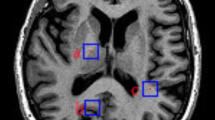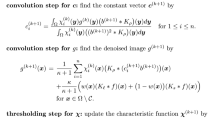Abstract
Chan-Vese (CV) model is a well-known mathematical model for image segmentation; however, it has difficulty handling images with inhomogeneous intensity. Many models have been proposed to address this difficulty. In this paper, we propose a locally enhanced Chan-Vese model (LECV) to successfully segment images with intensity inhomogeneity. We define a new signed pressure force (SPF) function based on the local image information from a triangular mesh representation. The anisotropic mesh representation (AMA representation) of the image also helps improving the computational accuracy and efficiency. Numerical results demonstrate that our proposed LECV model provides better segmentation for images with inhomogeneous intensity than the traditional Chan-Vese model as well as a few commonly used models.
Access this chapter
Tax calculation will be finalised at checkout
Purchases are for personal use only
Similar content being viewed by others
References
Fang, L., Zhao, W., Li, X., Wang, X.: A convex active contour model driven by local entropy energy with applications to infrared ship target segmentation. Opt. Laser Technol. 96, 166–175 (2017)
Bialas, J., Oommen, T., Havens, T.C.: Optimal segmentation of high spatial resolution images for the classification of buildings using random forests. Int. J. Appl. Earth Obs. Geoinf.Geoinf. 82, 101895 (2019)
Zhang, W., Wang, X., Zhang, P., Chen, J.: Global optimal hybrid geometric active contour for automated lung segmentation on CT images. Comput. Biol. Med.. Biol. Med. 91, 168–180 (2017)
Tong, S.-G., Huang, Y.Y., Tong, Z.M.: A robust face recognition method combining LBP with multi-mirror symmetry for images with various face interferences. Int. J. Autom. Comput.Autom. Comput. 16(5), 671–682 (2019)
Chun, L., Chunhua, X., Jian, Y., Yingying, X., Junliang, B.: A method for coastal oil tank detection in polarimetrie SAR images based on recognition of T-shaped harbor. J. Syst. Eng. Electron. 29(3), 499–509 (2018)
Guan, S.-Y., Wang, T.-M., Meng, C., Wang, J.-C.: A review of point feature based medical image registration. Chin. J. Mech. Eng. 31(1), 1–16 (2018)
Mumford, D.B., Shah, J.: Optimal approximations by piecewise smooth functions and associated variational problems. Commun. Pure Appl. Math. Pure Appl. Math. 42(5), 577–685 (1989)
Chan, T.F., Vese, L.A.: Active contours without edges. IEEE Trans. Image Process. 10(2), 266–277 (2001)
Xu, C., Prince, J.L.: Snakes, shapes, and gradient vector flow. IEEE Trans. Image Process. 7(3), 359–369 (1998)
Badoual, A., Unser, M., Depeursinge, A.: Texture-driven parametric snakes for semi-automatic image segmentation. Comput. Vis. Image Underst.. Vis. Image Underst. 188, 102793 (2019)
Liu, G., Deng, M.: Parametric active contour based on sparse decomposition for multi-objects extraction. Signal Process. 148, 314–321 (2018)
Bai, J., Shah, A., Wu, X.: Optimal multi-object segmentation with novel gradient vector flow based shape priors. Comput. Med. Imaging Graph.. Med. Imaging Graph. 69, 96–111 (2018)
Han, B., Wu, Y.: Active contours driven by global and local weighted signed pressure force for image segmentation. Pattern Recogn.Recogn. 88, 715–728 (2019)
Liux, C., Liu, W., Xing, W.: An improved edge-based level set method combining local regional fitting information for noisy image segmentation. Signal Process. 130, 12–21 (2017)
Ding, K., Xiao, L., Weng, G.: Active contours driven by local pre-fitting energy for fast image segmentation. Pattern Recogn. Lett.Recogn. Lett. 104, 29–36 (2018)
Yu, H., He, F., Pan, Y.: A scalable region-based level set method using adaptive bilateral filter for noisy image segmentation. Multimed. Tools Appl. 79(9), 5743–5765 (2020)
Liu, H., Fang, J., Zhang, Z., Lin, Y.: A novel active contour model guided by global and local signed energy-based pressure force. IEEE Access 8, 59412–59426 (2020)
Abdelsamea, M,M., Tsaftaris, S.A.: Active contour model driven by globally signed region pressure force. In: 2013 18th International Conference on Digital Signal Processing (DSP) (2013)
Song, H.: Active contours driven by regularised gradient flux flows for image segmentation. Electron. Lett. 50(14), 992–994 (2014)
Chen, L., Zhou, Y., Wang, Y., Yang, J.: GACV: geodesic-aided C-V method. Pattern Recogn.Recogn. 39(7), 1391–1395 (2006)
Caselles, V., Kimmel, R., Sapiro, G.: Geodesic active contours. Int. J. Comput. VisionComput. Vision 22(1), 61–79 (1997)
Zhang, K., Zhang, L., Song, H., Zhou, W.: Active contours with selective local or global segmentation: A new formulation and level set method. Image Vis. Comput.Comput. 28(4), 668–676 (2010)
Li, C., Kao, C.-Y., Gore, J.C., Ding, Z.: Implicit active contours driven by local binary fitting energy. In: 2007 IEEE Conference on Computer Vision and Pattern Recognition (2007)
Li, C., Kao, C.-Y., Gore, J.C., Ding, Z.: Minimization of region-scalable fitting energy for image segmentation. IEEE Trans. Image Process. 17(10), 1940–1949 (2008)
Zhang, K., Song, H., Zhang, L.: Active contours driven by local image fitting energy. Pattern Recogn.Recogn. 43(4), 1199–1206 (2010)
Wang, L., Li, C., Sun, Q., Xia, D., Kao, C.-Y.: Active contours driven by local and global intensity fitting energy with application to brain MR image segmentation. Comput. Med. Imaging Graph. 33(7), 520–531 (2009)
Wang, H., Huang, T.-Z., Xu, Z., Wang, Y.: A two-stage image segmentation via global and local region active contours. Neurocomputing 205, 130–140 (2016)
Wang, L., He, L., Mishra, A., Li, C.: Active contours driven by local Gaussian distribution fitting energy. Signal Process. 89(12), 2435–2447 (2009)
Wang, P., Sun, K., Chen, Z.: Local and global intensity information integrated geodesic model for image segmentation. In: 2012 International Conference on Computer Science and Electronics Engineering (2012)
Tran, T.-T., Pham, V.-T., Chiu, Y.-J., Shyu, K.-K.: Active contour with selective local or global segmentation for intensity inhomogeneous image. In: 2010 3rd International Conference on Computer Science and Information Technology (2010)
Li, X., Jiang, D., Shi, Y., Li, W.: Segmentation of MR image using local and global region based geodesic model. Biomed. Eng. Online 14(1), 02 (2015)
Abbas K., Li, X.: Anisotropic mesh adaptation for image segmentation based on Mumford-Shah functional. 17 July 2020. https://arxiv.org/abs/2007.08696, unpublished
Huang, W., Li, X.: An anisotropic mesh adaptation method for the finite element solution of variational problems. Finite Elem. Anal. Des. 46, 61–73 (2010)
Li, X., Huang, W.: An anisotropic mesh adaptation method for the finite element solution of heterogeneous anisotropic diffusion problems. J. Comput. Phys.Comput. Phys. 229(21), 8072–8094 (2010)
Li, X., Huang, W.: Maximum principle for the finite element solution of time-dependent anisotropic diffusion problems. Numeric. Methods Partial Differ Equ. 29, 1963–1985 (2013)
Li, X.: Anisotropic mesh adaptation for finite element solution of anisotropic porous medium equation. Comput. Math. Appl.. Math. Appl. 75, 2086–2099 (2018)
Huang, W.: Mathematical principles of anisotropic mesh adaptation. Commun. Comput. Phys 1(2), 276–310 (2006)
Li, X.: Anisotropic mesh adaptation for image representation. EURASIP J. Image Video Process. 2016(1), 1–16 (2016). https://doi.org/10.1186/s13640-016-0132-7
Huang, W.: Metric tensors for anisotropic mesh generation. J. Comput. Phys.Comput. Phys. 204(2), 633–665 (2005)
Two Apples Red and Green wesbite. https://www.tapeciarnia.pl/94419_dwa_jablka_czerwone_zielone
Haddad, I.: Outdoor Plants: Chinese Evergreen (2020). https://pep-khaoula.netlify.app/product/chinese-evergreen
Author information
Authors and Affiliations
Corresponding author
Editor information
Editors and Affiliations
Rights and permissions
Copyright information
© 2024 The Author(s), under exclusive license to Springer Nature Switzerland AG
About this paper
Cite this paper
Abbas, K.K., Li, X. (2024). Locally Enhanced Chan-Vese Model with Anisotropic Mesh Adaptation for Intensity Inhomogeneous Image Segmentation. In: Arai, K. (eds) Intelligent Systems and Applications. IntelliSys 2023. Lecture Notes in Networks and Systems, vol 824. Springer, Cham. https://doi.org/10.1007/978-3-031-47715-7_9
Download citation
DOI: https://doi.org/10.1007/978-3-031-47715-7_9
Published:
Publisher Name: Springer, Cham
Print ISBN: 978-3-031-47714-0
Online ISBN: 978-3-031-47715-7
eBook Packages: Intelligent Technologies and RoboticsIntelligent Technologies and Robotics (R0)




